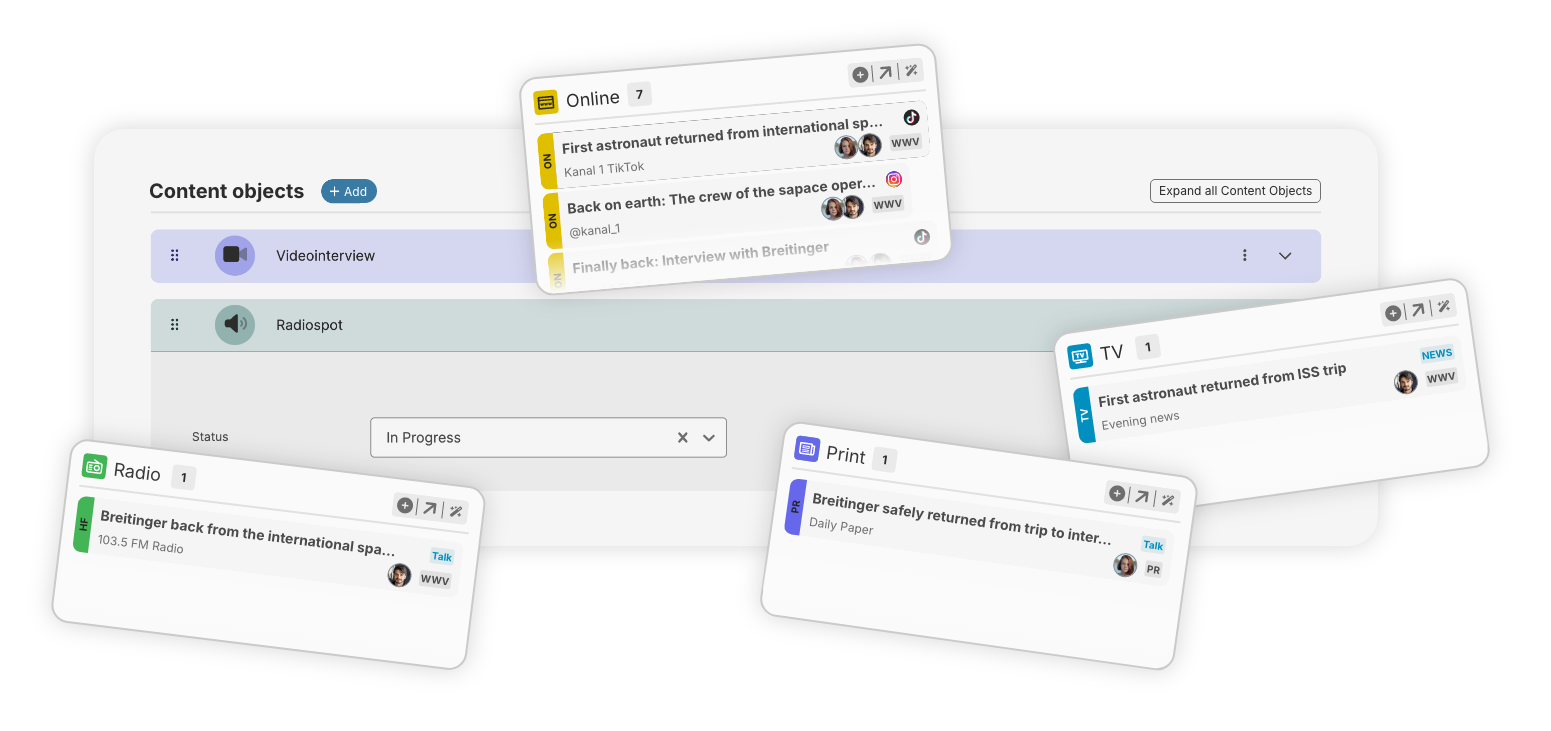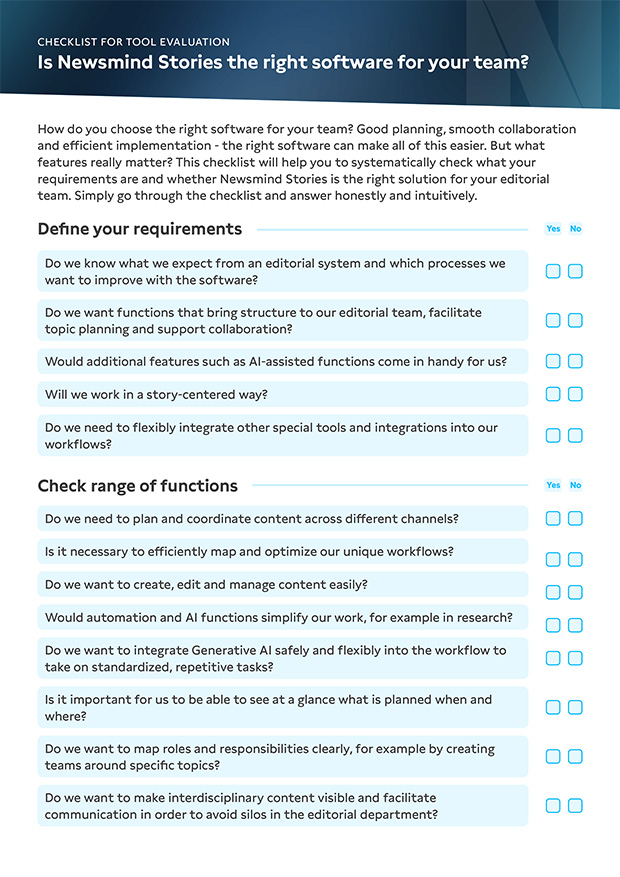Whether online, print, or television: Editorial systems support the complex workflows that need to be managed every day in editorial teams across various media houses. They simplify all journalistic and content-specific tasks and assist editors in managing assets and content, developing channel-specific outputs, and cross-media publishing of new content. Here, we explain what to look for in an editorial system for media production and which features help publishers and broadcasters.
Content of this page

What is an editorial system?
An editorial system is software for the efficient management of editorial content and offers a solution to the chaos of tools and files with Word, Excel, InDesign, etc. Editorial software helps to bundle topics, content and media in one place, to use them multiple times and thus to be able to play them out effectively on different channels. It simplifies and supports processes such as
- Sorting of content and topics
- Editing and administration
- Preparing multimedia content (text, video, audio, graphics)
- Publishing the content in the desired output channel.
A characteristic feature of editorial software is the separation of content, format and structure so that media creators can work independently of the layout. Editorial systems also offer the option of managing access and user rights as required and storing defined workflows for content management.
Content teams use editorial systems to set up standardized processes, for example to create new articles more quickly and publish them more easily on a website or via social media platforms.
But editorial systems or editorial software not only support digital products: Processes relating to print products, podcasts or videos can also be automated with the appropriate software. This makes cross-media content management easier and more successful – both in journalistic editorial offices and newsrooms as well as in publishing houses or corporate newsrooms as part of corporate publishing.
How the separation of content, format, and structure works and how newsrooms benefit from it is explained on our page about crossmedia publishing.
What is the difference between editorial software and content management systems?
Editorial system or content management system (CMS)? Due to their functional relationship, users often equate editorial systems and content management systems. This is not entirely wrong, but a CMS can rather be seen as an extension or supplement. This is because a CMS is primarily used to maintain, store and provide digital content for a website, for example.
Examples of well-known CMSs that can be used to create websites or stores:
- WordPress
- Wix
- Drupal
- Shopify
- Squarespace
A CMS is therefore part of an editorial system. However, editorial software is not limited to websites as a publication channel and should support cross-media work. With an editorial system, it is therefore possible to play out content in any channel: from print media such as newspapers, magazines and brochures to digital channels such as websites and apps through to formats for corporate communications. Newsmind Stories is an example of such a modern editorial system for planning, managing and publishing.

How does an editorial system work?
Despite their sometimes high functional complexity, modern editorial systems simplify the work of newsrooms and editorial teams. They make it possible to manage multimedia content efficiently, prepare it as required and publish it across all channels.
How does it work in simple terms?
The basis for content work is a central database with corresponding programming interfaces (Application Programming Interface, API for short) to the output systems such as website, Instagram, app, etc. Editorial software pulls the required content for publication on a channel from this central data source: this means that content is kept media-neutral (independent of the layout).
This enables a topic-centered way of working and once content has been created, it can be used multiple times and across different media and output simultaneously. Re-editing is therefore no problem: if the respective users have the rights stored directly in the editing tool, they can prepare the required content for the corresponding purpose and channel in a WYSIWYG editor (what you see is what you get) – without any programming knowledge.
Requirements of an editorial system
For comprehensive editorial planning and cross-media content publication, modern editorial software should especially meet the following requirements:
To ensure that employees can access content regardless of time, place and device, the software should be available as a web application, i.e. as an online editing system. This not only allows several people to work on the same content at the same time, but also to track each other’s changes and the status of documents transparently.
Ideally, an editing tool should have a clear, user-friendly web interface and be intuitive to use. This allows content managers to quickly familiarize themselves with the software and use it efficiently right from the start. An important component is an integrated editor with which editors can easily edit texts, links, graphics, videos, audio and other multimedia content, format them as required and combine them for specific channels.

For efficient collaboration, the editorial software should support a tailored rights and roles concept. Content managers define in the software which users or user groups are allowed to handle specific assets and content. For example, while editors may create and publish new content, employees from other departments might only have read access.
To publish multimedia content in the desired output channel, all content must be stored in the editorial system in a media-neutral format — meaning without graphical formatting and styling. This allows editors to efficiently process and repurpose the same content for various uses.
Keeping data media-neutral is only possible if the newsroom software supports the necessary separation of content and design. Single source publishing makes it possible to systematically provide reusable content and adapt the feed format of the respective asset for the desired publication channel.
An editorial system can only fulfill its primary purpose — cross-media content distribution — if it is connected to relevant output systems through application programming interfaces (APIs). This includes integration with media asset management (MAM) solutions, content management systems (CMS), broadcast management systems, and directory services such as Active Directory.
The larger the editorial team and the greater the variety of topics, the greater the volume of content produced. In order to find information quickly, a powerful search including customised filter options is essential. An important prerequisite is that editors provide each individual asset with meaningful metadata.
What benefits does an editorial system offer?
The functional characteristics of an editorial tool offer many advantages that support and simplify editorial work in the newsroom. Above all, the more frequently editorial offices use the same content in different publications, the more the use of an editorial system can benefit. The biggest advantages are:
Optimised workflows
A key advantage of content management software is that it makes team processes for creating, managing and publishing assets and content noticeably more efficient. Content managers not only work together more easily and better thanks to software. They also make fewer mistakes, while at the same time reducing the number of coordination and correction loops.
Centralized availability of assets and content
An editorial system acts as a central content hub that stores individual assets in various stages (draft or finalised) as well as communication concepts, editorial plans for social media and other channels. This gives editors an up-to-date overview of planned, current and completed measures at all times.
Work in a story-centred way
A shared database reduces the chaos of files, versions and drafts. Teams can plan topics and broadcasts together and then develop a topic in detail – with topic teams and responsibilities. This allows different stories to be published quickly and with consistent content across all channels.
Publish faster – everywhere
Thanks to the direct integration of social media, linked CMS or distribution systems or simple import and export options, every good editorial system enables content to be published quickly and with just a few clicks on the appropriate channels – without having to rely on IT or development resources.
Is Newsmind Stories the right software for your team?
Our checklist will help you to check what your requirements are and whether Newsmind Stories is the right solution for your team.

How do various editorial systems differ?
The type of editorial system a company chooses depends on its individual needs. Smaller newsrooms may be able to get by with an Excel list or the integrated functions in their content management system (CMS). Larger newsrooms in companies and journalistic editorial offices, on the other hand, require a tool that better addresses their specific needs. In the area of editorial topic planning in the media industry, the market is still quite undeveloped. There are differences between the available editorial tools, particularly with regard to
- Customizing,
- Social media management,
- Features for linear TV,
- Audio features,
- AI features and
- Monitoring.
As the media industry is in the midst of a disruptive change process – away from the linear media business and individual silos in the areas of television, radio, print and online towards a cross-media, cross-platform approach – modern editorial systems must enable multichannel publishing and bring together the planning levels for all channels. This also includes a powerful component for social media management.

The situation is somewhat different with regard to corporate newsrooms. Here, editorial software in the form of a CMS is already established in many places. The solutions differ in terms of AI-based process support, social media management, customising and monitoring.
WANT TO KNOW MORE ABOUT NEWSMIND STORIES?
Schedule a personal talk with us – for free and no strings attached.
What does an editorial system cost?
When introducing an editorial system, those responsible naturally weigh up the costs and benefits. Many are afraid that the implementation of an editorial tool will involve high acquisition costs. It can be particularly expensive if the software does not match the processes that a company wants to optimize. In addition to the purchase of licenses, costly customizing may be necessary to adapt the tool to the individual needs of a newsroom or editorial department.
In order to minimize the initial effort involved in implementation, it makes sense to choose editorial software that already offers many of the functions that a team needs, for example:
- AI functionalities
- Automatic monitoring of trends and topics
- Management of various social media platforms
- Automatic publication of multimedia content.
Above all, it is important that a system has a modular structure and also supports customised configurations out of the box, so that the software can be easily adapted to existing workflows – without much effort. This also ensures that a system can grow in the future – without major costs.
The future of editorial systems: Support
through AI
Technologies such as artificial intelligence, machine learning and natural language processing (NLP) automate and standardise a large number of processes along the content research, creation, editing, production and publication process. This significantly simplifies and accelerates their implementation. One example: AI in journalism or in editorial offices can simplify research and finding new trends and topics by automatically sorting incoming reports, pre-filtering them according to relevance and also displaying what the competition has already published on a planned topic.
In the future, AI-supported editorial systems will also be able to create forecasts: By analyzing vast amounts of historical and reach data (Big Data), the editorial tool derives predictions for future developments and develops a fairly reliable forecasting model: how good are the chances that a topic will develop into a trend? Does it have the potential to achieve a wide reach? Knowing what trends to expect enables teams to filter out the most promising topics from the multitude and to deploy their employees optimally to develop the right topics. In the future, AI will not only automatically determine in which format, for example, a video post should be played on which channel and convert it into the required video format. It will also predict when the ideal time will be to play the video.
How exactly artificial intelligence enriches work in the newsroom is detailed in FKT-Magazin – Issue 12/2020.
Editorial systems: Our conclusion
Editorial tools provide the essential technological foundation for any modern newsroom. Such content management software enables editors to efficiently manage multimedia content, prepare it as needed, and publish it across multiple channels. This not only helps staff in the newsroom handle the vast amounts of content but also meets the needs of their increasingly demanding audiences.
More interesting articles that you shouldn’t miss




